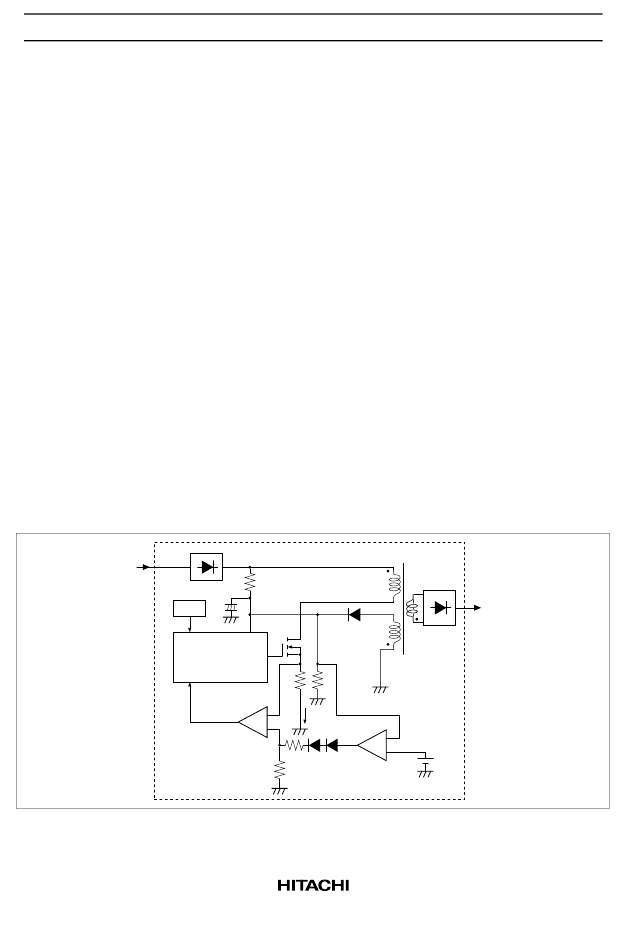- 您現(xiàn)在的位置:買賣IC網(wǎng) > PDF目錄370418 > HA17385HPS (Hitachi,Ltd.) High Speed Current Mode PWM Control IC for Switching Power Supply PDF資料下載
參數(shù)資料
| 型號: | HA17385HPS |
| 廠商: | Hitachi,Ltd. |
| 元件分類: | 基準(zhǔn)電壓源/電流源 |
| 英文描述: | High Speed Current Mode PWM Control IC for Switching Power Supply |
| 中文描述: | 高速開關(guān)電源電流模式PWM控制IC |
| 文件頁數(shù): | 15/31頁 |
| 文件大小: | 145K |
| 代理商: | HA17385HPS |
第1頁第2頁第3頁第4頁第5頁第6頁第7頁第8頁第9頁第10頁第11頁第12頁第13頁第14頁當(dāng)前第15頁第16頁第17頁第18頁第19頁第20頁第21頁第22頁第23頁第24頁第25頁第26頁第27頁第28頁第29頁第30頁第31頁

HA17384SPS/SRP, HA17384HPS/HRP, HA17385HPS/HRP
15
Features and Theory of Current Mode Control
Features of Current Mode Control
Switch element current detection is performed every cycle, giving a high feedback response speed.
Operation with a constant transformer winding current gives a highly stable output voltage (with
excellent line regulation characteristics, in particular).
Suitable for flyback transformer use.
External synchronous operation is easily achieved. (This feature, for example, is applicable to
synchronization with a forizontal synchronizing signal of CRT monitor.)
Theory of Current Mode Control
In current mode control, a PWM pulse is generated not by comparing an error voltage with a triangular
wave voltage in the voltage mode, but by changing the current limiter level in accordance with the error
voltage (COMP terminal in this IC, that is,output of the error amplifier output) which is obtained by
constantly monitoring the current of the switching device (power MOSFET) using source resistor R
CS
.
One of the features of current mode control is that the current limited operates in all cycles of PWM as
described by the above theory.
In voltage mode, only one feedback loop is made by an output voltage. In current mode, on the other hand,
two loops are used. One is an output voltage loop and the other is a loop of the switching device current
itself. The current of the switching device can be controlled switch high speed. In current mode control,
the current in the transformer winding is kept constant, resulting in high stability. An important
consequence is that the line regulation in terms of total characteristics is better than that in voltage mode.
Transformar
AC
input
Current sense
comparator
Error amplifier
DC
output
RS
2R
R
R
S
I
S
V
COMP
Vref
OSC
+
+
Flip flop
Figure 5 Block Diagram of Current Mode Switching Power Spply
相關(guān)PDF資料 |
PDF描述 |
|---|---|
| HA17384 | 250000 SYSTEM GATE 1.5 VOLT FPGA |
| HA17393 | Dual Comparator |
| HA17903FPK | Dual Comparator |
| HA17393F | Dual Comparator |
| HA17903 | 500000 SYSTEM GATE 1.5 VOLT FPGA |
相關(guān)代理商/技術(shù)參數(shù) |
參數(shù)描述 |
|---|---|
| HA17385HPS/HRP | 制造商:HITACHI 制造商全稱:Hitachi Semiconductor 功能描述:High Speed Current Mode PWM Control IC for Switching Power Supply |
| HA17385HRP | 制造商:RENESAS 制造商全稱:Renesas Technology Corp 功能描述:High Speed Current Mode PWM Control IC for Switching Power Supply |
| HA17385HRP(E) | 制造商:Renesas Electronics Corporation 功能描述: |
| HA17385PS | 制造商:未知廠家 制造商全稱:未知廠家 功能描述:Current-Mode SMPS Controller |
| HA17393 | 制造商:Panasonic Industrial Company 功能描述:I.C. |
發(fā)布緊急采購,3分鐘左右您將得到回復(fù)。